|
Child and Adult Care Food Program (CACFP)
2025 - 02
|
|
Alaska Department of Education and Early Development
Division of Finance and Support Services
Child Nutrition Programs
P.O. Box 110500
Juneau, AK 99811 |
|
Subscription Management
Are you receiving this message but don't want to receive it? Is there someone in your organization that should receive this but isn't? Manage your subscription on GovDelivery.
|
|
USDA Policy, Information, and Implementation Memos |
|
|
Sponsoring organizations and institutions are required by regulation to keep Bulletins, Instructions, and USDA Policy Memorandums for reference and to apply immediately the appropriate instruction to agency programs. The latest policy memos are found on the USDA FNS policy page. Call Child Nutrition Programs if you need further clarification.
CACFP 01-2025: Nutrition Requirements for Fluid Milk and Fluid Milk Substitutions in the Child and Adult Care Food Program, Questions and Answers
This memorandum details the nutrition requirements for fluid milk and fluid milk substitutes in the Child and Adult Care Food Program (CACFP) and includes a series of frequently asked questions and answers. In addition to the information included in previous memoranda, this memorandum specifically:
- Clarifies who may sign medical statements;
- Provides technical updates on units of measurement for vitamins A and D in fluid milk substitutes;
- Includes a table of the nutrition requirements for fluid milk substitutes;
- Provides information related to temporary and ongoing unavailability of fluid milk;
- Adopts standardized terminology such as “institutions and facilities;” and
- Reorganizes information throughout the memorandum for clarity.
CACFP 02-2025: Offer Versus Serve and Family Style Meals in the Child and Adult Care Food Program
The purpose of this memorandum is to outline the use of Offer Versus Serve (OVS) in the adult day care and at-risk afterschool settings, as well as the use of family style meals in the Child and Adult Care Food Program (CACFP). This memorandum contains two attachments that highlight frequently asked questions and answers and OVS examples for breakfast, lunch, and supper meal service. In addition to the information included in previous memoranda, this memorandum specifically:
- Updates terminology from “food component” to “meal component” per CACFP regulations;
- Updates definitions listed under “Terms to Know;”
- Includes two new questions clarifying policy regarding meals for supervising adults (#13) and meal accommodations (#14);
- Includes an attachment with updated examples of OVS;
- Adopts standardized terminology such as “institutions and facilities;” and
- Reorganizes information throughout the memorandum for clarity.
CACFP 03-2025: Substituting Vegetables for Grains in American Samoa, Guam, Hawaii, Puerto Rico, the U.S. Virgin Islands, and Tribal Communities
This memorandum clarifies longstanding program regulations and provides updated guidance on the use of vegetables as a substitution for grains, including whole grain-rich products, in eligible areas, as described in program regulations. This guidance also provides updates on the expansion of this flexibility to eligible areas following the 2024 final rule. Lastly, this memorandum informs affected state agencies and program operators how to credit vegetables toward the grains component for all CNPs, including the NSLP, SBP, SFSP, and CACFP.
CACFP 04-2025: Guidance for Accepting Processed Product Documentation for Meal Pattern Requirements
The purpose of this memorandum is to provide State agencies and program operators with additional information and clarification on the State agency monitoring process regarding the: 1) Child Nutrition (CN) label, 2) Watermarked CN label, and 3) manufacturer’s Product Formulation Statement (PFS). This memorandum also reflects updates to the CN Label Verification System and provides clarification on the date of authorization found on the CN label versus the “Valid Until” date on the CN Label Verification Report.
|
|
Additional Topics
Please be aware of our annual renewal/application deadlines. Thank you for all your work on getting your applications submitted in time.
Reminder about your Non-Profit Food Service (NPFS) Report:
- Please note that you must submit your September claim first so that you’ll know the total program reimbursement and total expenses. If you are done with your September claims, you are welcome to send the NPFS to us.
- The form can be downloaded from the Checklist tab on CNP Web.
- If this is your first time completing the NPFS Report, you are welcome to reach out to cnp.cacfp@alaska.gov
New Area Eligibility for CACFP
At the beginning of the fiscal year, FNS releases a special tabulation of data provided by the United States Census Bureau for CACFP and SFSP that can be used to establish area eligibility. The FNS mapping tools have been updated to reflect the October 1, 2025 changes.
To explore the area eligibility map, click this link. The data set is also available for download on FNS’ open data site. To learn more about using census data for establishing area eligibility for CACFP and SFSP, please review our policy memorandum from 2017.
Fire Inspections
Unlicensed sites operating CACFP are required to submit their most recent fire inspection to us, preferably one that was conducted in the last two years. However, we recognize that sites located in rural areas may not have the same opportunity that other urban sites have to receive regular fire inspections.
If you have a site that has not received an inspection, please do the following:
1. Request for an inspection from your fire authority. The Division of Fire and Life Safety has statewide jurisdiction for fire code enforcement and plan review authority, except in communities which have received deferrals.
2. Complete a Self-Inspection Form, which you can use for your records and requirements. The appropriate form can be downloaded from the Life Safety Inspection Bureau page. You are not required to send this to the fire marshal for review.
When the Division of Fire and Life Safety travels to your community, they will have a list of buildings that they will inspect. If your building is inspected, the building representative will be given a copy of the inspection which they may share with you.
Being in a deferred jurisdiction doesn't mean you are exempt from this requirement; it just means you will need to contact a different fire agency for your local procedures. For a list of deferred jurisdictions, please visit the Life Safety Inspection Bureau page for contact information.
|
|
Webinars & Conferences
Registration Now Open for the 2025 National Child Nutrition Conference
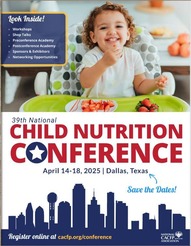
The 39th National Child Nutrition Conference, provided by the National CACFP Association (NCA), is now open for registration.
The National Child Nutrition Conference is an annual event that brings together professionals from child care centers, home providers, sponsoring organizations, school districts, afterschool programs, Head Start programs, Food Banks, tribal nations and State Agencies.
The 2025 National Child Nutrition Conference will be held April 14-28, 2025, in Dallas, Texas.
|
Winter Wellness: Nurturing Immune Health in Kids
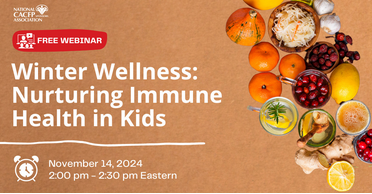
The National CACFP Sponsors Association (NCA) is hosting a webinar that lets you get ahead of the flu season. Help prevent colds and flus by giving an extra boost of health to those in your care through providing immune-supporting nutritional foods and activities. Learn how to convert your child care center and family child care home into a fortress of wellness by adding delicious recipes to your menu and fun games to keep their bodies in top working order.
This free webinar is on Nov 14, Thursday, 10:00 am - 12:00 noon Alaska.
|
Menu Planning in the CACFP

Brought to you by the National CACFP Sponsors Association, the Menu Planning Boot Camp will be available via Zoom November 20-21, 2024.
Get ready to become a menu planning expert with our Menu Planning Boot Camp! In just two days of training, you'll learn to understand CACFP menu requirements, how to select budget-friendly and accessible foods, and gain valuable insights from kitchen professionals.
Discover tips and techniques to unlock your inner chef and elevate your meal planning skills. Provide nutritious and delicious meals for those in your care with newfound confidence and expertise.
Early registration rates for this boot camp are $149 for NCA members and $199 for non-members.
|
|
|
Recipes & Resources

Centers for Disease Control and Prevention Resources
The Centers for Disease Control and Prevention has provided a list of resources for Early Care and Education providers:
- Improving nutrition, physical activity, and breastfeeding in early care and education (ECE) settings. ECE providers are on the frontline of public health and are valuable partners in safeguarding the health and well-being of young children and families. CDC offers many resources, from free training to educational materials to share with families, through the Early Care and Education Portal.
- Starting good nutrition practices early can empower children to develop healthy dietary patterns that will benefit them throughout their lives. CDC’s Infant and Toddler Nutrition website is another resource that public health professionals, health care providers, and the public can access for information and practical strategies on feeding healthy foods and drinks to infants and toddlers.
In addition to the many resources related to young children that I’ve already mentioned, CDC publishes timely, relevant feature articles. Here are just a few:
- Breastfeeding Benefits Both Baby and Mom
- Good Nutrition Starts Early
- Mealtime Routines and Tips
- Tips to Help Your Picky Eater
- Achieving continuity of care for mothers who breastfeed. Breastfeeding has many health benefits for infants, children, and mothers. Communities, workplaces, childcare agencies, hospitals, health care providers, lactation support providers, and related social services can make breastfeeding easier. CDC provides information, resources, and data to help with breastfeeding efforts. They recently released new breastfeeding rates that can be used to help inform decisions for supporting breastfeeding at state and national levels.
Your role in promoting the health of young children is important and valued, and CDC wants to help you to help others. A healthy start for young children can set them up for good health throughout their lives.
|
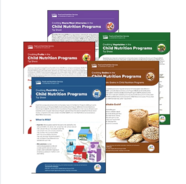
Crediting Tip Sheets
The Crediting in the Child Nutrition Programs Tip Sheet series has been revised to reflect the changes with the Final Rule, Child Nutrition Programs: Meal Patterns Consistent With the 2020-2025 Dietary Guidelines for Americans. The Crediting in the Child Nutrition Programs tip sheet series consists of seven tip sheets covering the five meal components: fluid milk, fruits, vegetables, meats/meat alternates, and grains (three separate tip sheets). The revised versions introduce the menu-planning flexibilities beginning July 1, 2024 and changes that will implemented in the coming school years in a quick-reference format.
|
Harvest of the Month
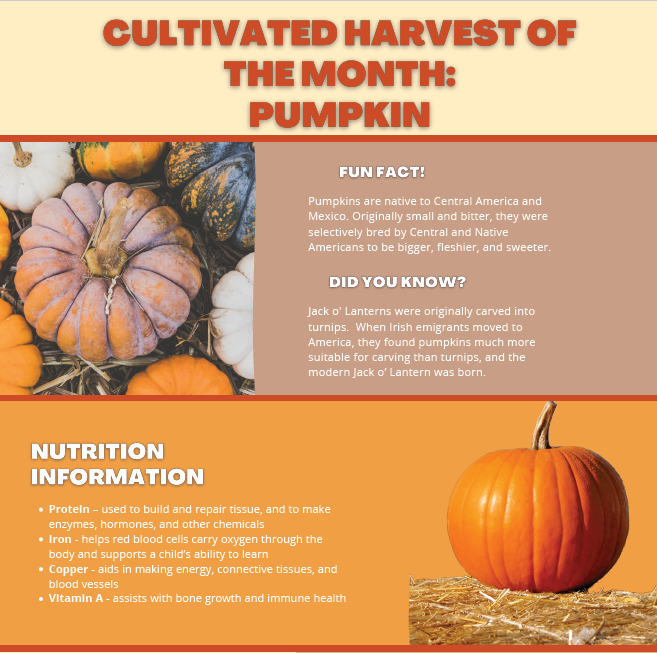 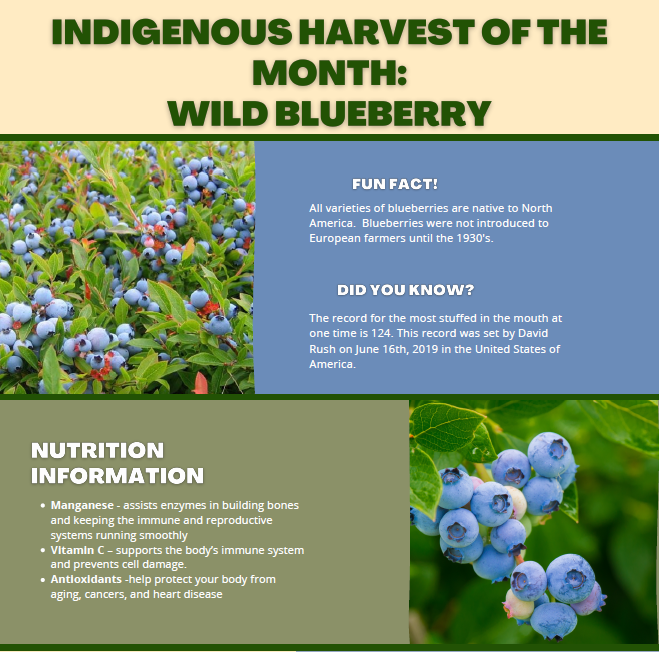 To find out more about Harvest of the Month resources, please contact Waverli Stowe at waverli.stowe@alaska.gov.
Team Nutrition Resources
|
|
Contact Us
Child and Adult Care Food Program
School Meals
Summer Meals
Food Distribution Program
Fresh Fruit & Vegetable Program
|
Farm to School
The Emergency Food Assistance Program
Child Nutrition Grants
Child Nutrition Financial Management
|
|
|
This newsletter contains hyperlinks to information created and maintained by other public and private organizations. These links are provided for the reader’s convenience. DEED does not control or guarantee the accuracy, relevance, timeliness, or completeness of this outside information. Furthermore, the inclusion of links is not intended to reflect their importance, nor is it intended to endorse any views expressed, or products or services offered, on these sites, or the organizations sponsoring the sites.
USDA Nondiscrimination Statement (English)
In accordance with federal civil rights law and U.S. Department of Agriculture (USDA) civil rights regulations and policies, this institution is prohibited from discriminating on the basis of race, color, national origin, sex (including gender identity and sexual orientation), disability, age, or reprisal or retaliation for prior civil rights activity.
Program information may be made available in languages other than English. Persons with disabilities who require alternative means of communication to obtain program information (e.g., Braille, large print, audiotape, American Sign Language), should contact the responsible state or local agency that administers the program or USDA’s TARGET Center at (202) 720-2600 (voice and TTY) or contact USDA through the Federal Relay Service at (800) 877-8339.
To file a program discrimination complaint, a Complainant should complete a Form AD-3027, USDA Program Discrimination Complaint Form which can be obtained online at: https://www.usda.gov/sites/default/files/documents/USDA-OASCR%20P-Complaint-Form-0508-0002-508-11-28-17Fax2Mail.pdf, from any USDA office, by calling (866) 632-9992, or by writing a letter addressed to USDA. The letter must contain the complainant’s name, address, telephone number, and a written description of the alleged discriminatory action in sufficient detail to inform the Assistant Secretary for Civil Rights (ASCR) about the nature and date of an alleged civil rights violation. The completed AD-3027 form or letter must be submitted to USDA by:
-
mail: U.S. Department of Agriculture Office of the Assistant Secretary for Civil Rights 1400 Independence Avenue, SW Washington, D.C. 20250-9410; or
-
fax: (833) 256-1665 or (202) 690-7442; or
-
email: program.intake@usda.gov
This institution is an equal opportunity provider.
|
|
|
|
|